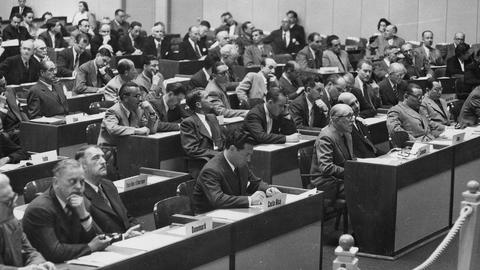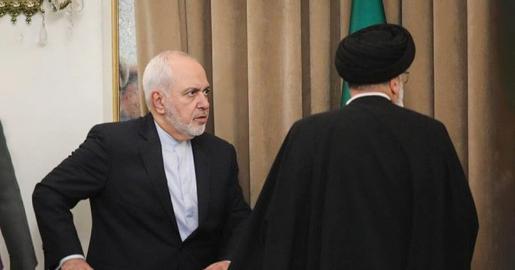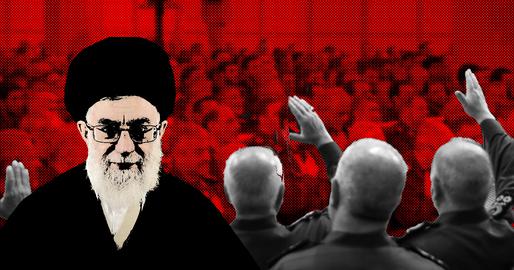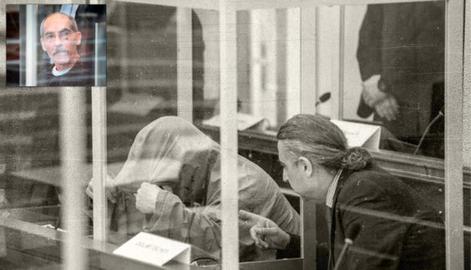The use of civilians, prisoners of war, medics and other protected individuals as “human shields” in military conflict has been forbidden under international law for almost 45 years. It refers to the deliberate placing of civilians between an attacker and a legitimate military target in order to deter attacks. Despite Iran’s existing commitments, the Islamic Republic has a complicated relationship with this basic principle and has violated it several times over.
The regime’s use of human shields has come back to the attention of the Iranian public in recent weeks after the anniversary of the IRGC’s downing of Ukrainian Airlines Flight 752. The civilian passenger plane was allowed to take off over Tehran at a time of heightened military tensions with the US, then shot out of the sky by two missiles, killing all 176 onboard.
Several of the victims’ devastated families have alleged that their loved ones were “human shields”, as the plane was given the green light to fly barely two hours after Iran launched a missile attack on the US Ain al-Assad Airbase in Iraq. Two grieving parents, the mother and father of Flight 752 victims Zeinab and Mohammad Asadi Lari, went further. The pair have said in a TV interview that shortly after the disaster, IRGC commander Hossein Salami came to their house and told them in no uncertain terms that had their children not died, a war would have broken out, and “10 million people” could have been killed.
In the circumstances, the couple inferred that the IRGC had intentionally used their children, and 174 other civilians from six countries of the world, as human shields. Naturally Islamic Republic of Iran Broadcasting’s PR department wasted no time issuing a statement denying the claim, but this did nothing to quell public outrage, in Iran and elsewhere.
Iran’s Position in International and Domestic Law
Iran is a signatory to Protocol I of the Geneva Conventions, part of the Additional Protocols signed in 1977, which expressly forbids the use of civilians as human shields. It was not until the 1998 Rome Statute that the use of human shields was formally recognized as an intentional war crime.
Iran is not a signatory to the Rome Statute, but its obligations under the Protocol I still stand as these types of agreements are binding on countries regardless of any regime change. The UN security council also has the power to refer individuals – be they commanders, soldiers or top decision-makers – from non-signatory states to the International Criminal Court in The Hague.
The Islamic Republic’s position on the use of human shields, however, is compromised by a fundamental conflict of interest. Incredibly the first Supreme Leader of the Islamic Republic, Ruhollah Khomeini, issued a fatwa on the subject that not only did not pronounce it haram – forbidden – but actively enabled the crime.
Recorded on Khomeini’s official website, the fatwa is states: "Question: If enemy forces take some Muslims, such as women, children, and old men, as shields, is it permissible to kill the mentioned Muslims? Answer: If the defense of Islam and Muslims and the suppression of aggressors is the subject at hand, it is permissible."
Khomeini also brought up the subject in a speech on August 18, 1981. Speaking at his residence in Jamaran, he said: “If corrupt Iraq makes a [human] shield of a group of innocent Muslims, it is obligatory for us to kill both Muslims and non-Muslims; the Muslims are martyrs, and go to heaven, and the infidels are infidels, and go to hell."
The Weight of Khomeini’s Words in the Iran-Iraq War
Ayatollah Khomeini's jurisprudential views as the Supreme Leader and the first absolute power after the Islamic Revolution shaped the course of the eight-year war with Iraq. During the conflict, commanders repeatedly rubber-stamped the abuse of civilians, with volunteers sent in to clear landmines or ford rivers.
When it was reported that Hossein Fahmideh, a 13-year-old boy, had tied himself to a grenade and scrambled under an Iraqi tank, blowing it up and inflicting enemy casualties, the Islamic Republic hailed him as a “martyr”. Later, however, it emerged that the whole account had been forged in a bid to encourage real citizens to carry out similar acts on behalf of the military.
Then in mid-1982, Iran launched Operation Ramadan: a massive six-week offensive launched near Basra that saw wave upon wave of infantry sent in in the largest land battle since World War II. Among them were also drafted-in civilians. In all, 20,000 people were killed and wounded. The same happened at the botched Operation Karbala-4 in 1986, led by IRGC commanders including Mohsen Rezaei against the advice of some lower-ranking political and military officials. That assault on the southern front left 12,000 Iranians dead.
A Legacy in Neighboring Countries
Proxy militant groups established and funded by the Islamic Republic in Iraq, Lebanon and Syria have a documented history of using human shields in their on-the-ground skirmishes. One notable pattern of behavior especially in Syria has been to place munitions factories, bases and warehouses filled with arms and explosives in the middle of densely-packed residential areas.
Many of the rockets and light missiles fired on US and Israeli targets in the region have been fired from inside residential buildings. The same tactic has been deployed by Hamas in the Palestinian Territories.
At one stage during the civil war in Syria, in which the Islamic Republic backed Bashar al-Assad via the IRGC Quds Force and proxies, the United Nations reported that pro-government forces were using abducted children as human shields, tying them to the windows of buses carrying troops to prevent opposition groups from shooting at them. The UN estimates that 1,200 children are killed each year as a result of using human shields.
In a shock statement in 2019, retired IRGC general Saeed Ghasemi claimed that during the 1992-1995 Bosnian War the IRGC had trained jihadist forces in Europe under cover of the Red Crescent. And not two weeks ago, it emerged the IRGC Quds Force under Ghasem Soleimani had inexplicably accompanied Red Crescent medics – whose insignia is a universally-accepted “don’t shoot” sign – into conflict-racked Libya.
An Ominous Recent Admission
Many of those acquainted with the PS752 disaster reasonably believe the passengers and crew were used as human shields due to Tehran’s failure to close civilian airspace at a time when a full-scale military confrontation was possible. The decision came despite advice to the contrary being given to the General Staff of the Armed Forces.
Another, more explicit instance took place the very same day. On January 8, a thousands-strong crowd of regime loyalists, mostly clerics from Qom, flocked to Ayatollah Khamenei’s headquarters to hear his annual speech on the anniversary of the Qom uprising, which was being broadcast live on TV for the first time.
Later, it transpired there was good reason for both the crowds, and the broadcast. IRGC Brigadier General Amir Ali Hajizadeh revealed in April that both Khamenei’s residence and “cultural sites” were among 52 potential targets in Iran that the US had said it would strike in the event of retaliation for the killing of Ghasem Soleimani – which had just happened, in the form of the attack on Ain al-Assad.
“They thought Iran should hold back and do nothing,” Hajizadeh said. “They intended to hit the Supreme Leader's residence, but on his decision, an operation was carried out immediately, and the program was broadcast live for the first time. This move sent a message and disrupted their plans."
Related coverage:
The Guards Used Khamenei's Audience as a Human Shield
Families Release Fresh PS752 Evidence as Trial Continues in Iran
Iran's Judiciary Exonerates Top Officials For Flight 752
Hezbollah Exposes its Own Missile Factory in Ill-Judged Media Tour
Explosion Reveals Lebanese Hezbollah Using Homes as Arms Stores
Did the Quds Force Exploit the Red Crescent in a War Zone?
Iran used Red Crescent as Cover for Revolutionary Guards
Iran Still Uses Child Soldiers — And There’s No Way to Stop It
visit the accountability section
In this section of Iran Wire, you can contact the officials and launch your campaign for various problems





























comments